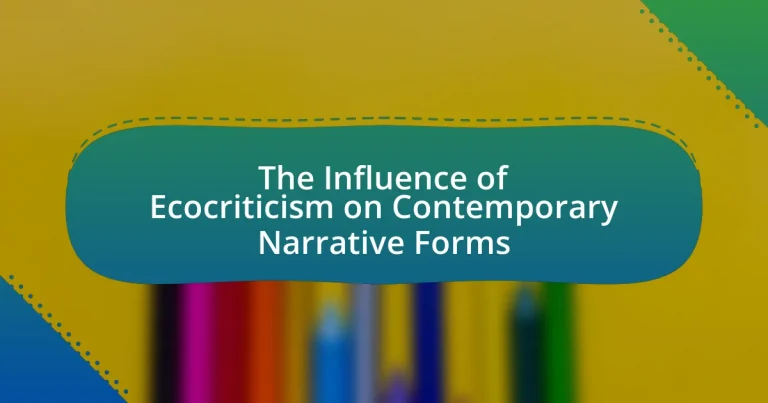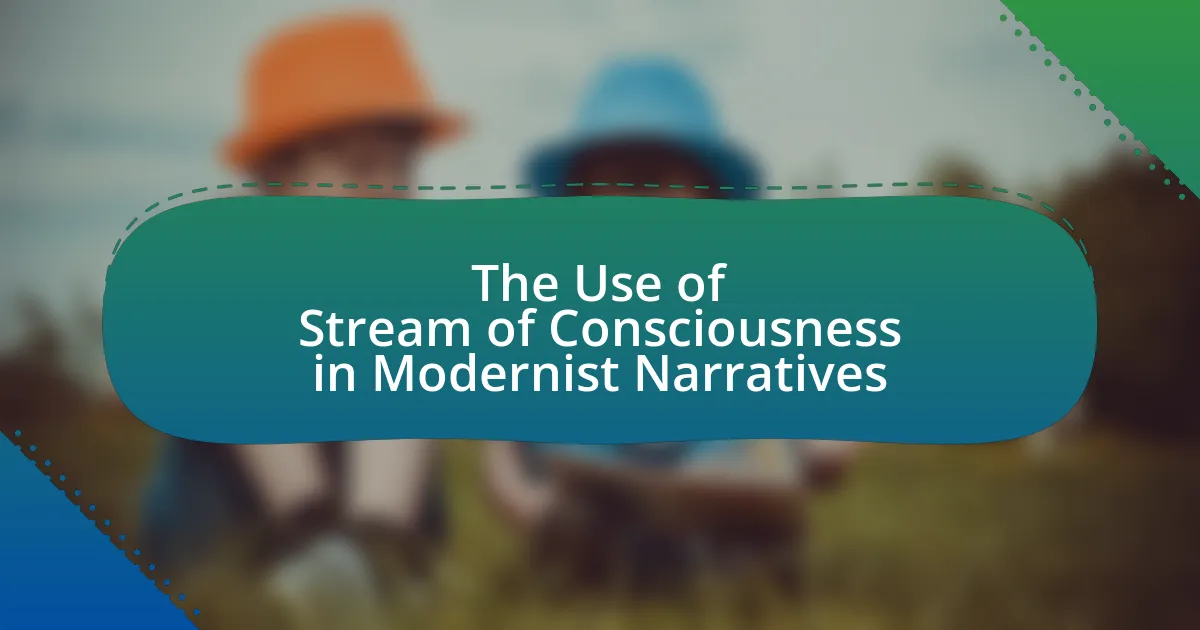Ecocriticism is a literary movement that significantly influences contemporary narrative forms by integrating environmental themes and perspectives into storytelling. This article explores how ecocriticism has evolved from a niche focus on nature writing to a broader interdisciplinary approach that examines literature’s relationship with environmental issues. Key principles of ecocriticism, such as critiquing anthropocentrism and emphasizing the interconnectedness of human and non-human life, are discussed alongside their manifestation in modern narratives. The article also highlights the emergence of new genres like eco-fiction and the impact of ecocriticism on character development, narrative techniques, and reader perceptions of nature, ultimately underscoring its significance in addressing urgent ecological concerns.
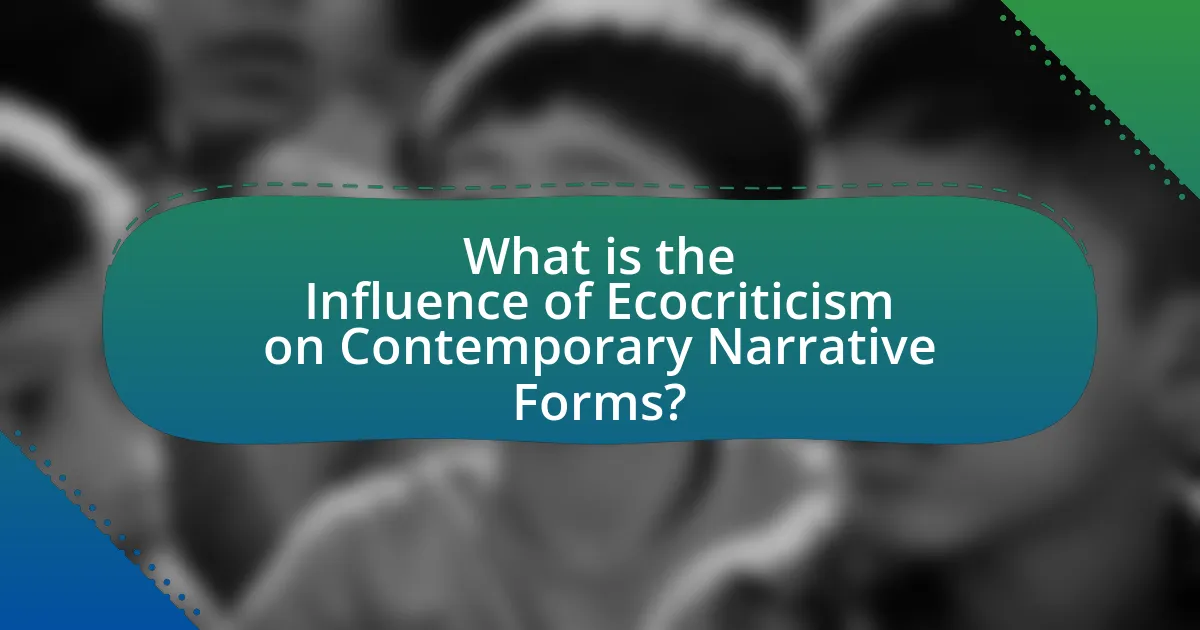
What is the Influence of Ecocriticism on Contemporary Narrative Forms?
Ecocriticism significantly influences contemporary narrative forms by integrating environmental themes and perspectives into storytelling. This literary movement encourages authors to explore the relationship between humans and the natural world, often highlighting ecological issues such as climate change, biodiversity loss, and sustainability. For instance, novels like “The Overstory” by Richard Powers exemplify how narrative structures can intertwine multiple perspectives on nature, emphasizing interconnectedness and ecological awareness. Furthermore, ecocriticism has led to the emergence of new genres, such as eco-fiction, which specifically addresses environmental concerns, thereby reshaping traditional narrative techniques to reflect ecological realities. This shift in narrative form not only raises awareness but also fosters a deeper understanding of humanity’s impact on the environment, making it a crucial element in contemporary literature.
How has ecocriticism evolved in literary studies?
Ecocriticism has evolved in literary studies from a niche perspective focused primarily on nature writing to a broader interdisciplinary approach that examines the relationship between literature and environmental issues. Initially, ecocriticism emerged in the 1990s, emphasizing the representation of nature in texts and critiquing anthropocentrism. Over time, it has expanded to include diverse genres and cultural contexts, integrating insights from environmental science, philosophy, and social justice. This evolution is evidenced by the increasing number of scholarly publications and conferences dedicated to ecocritical discourse, such as the establishment of the Association for the Study of Literature and Environment in 1992, which has fostered a global dialogue on ecological themes in literature.
What are the key principles of ecocriticism?
The key principles of ecocriticism include the examination of the relationship between literature and the environment, the critique of anthropocentrism, and the exploration of ecological themes in texts. Ecocriticism emphasizes the interconnectedness of human and non-human life, advocating for a perspective that values nature and its representation in literature. This approach often critiques the dominance of human-centered narratives, promoting a more inclusive understanding of ecological systems. Additionally, ecocriticism encourages the analysis of how literature reflects and shapes environmental attitudes, highlighting the role of storytelling in fostering ecological awareness and responsibility.
How do these principles manifest in contemporary narratives?
Ecocriticism principles manifest in contemporary narratives through the integration of environmental themes, character relationships with nature, and critiques of anthropocentrism. For instance, novels like “The Overstory” by Richard Powers illustrate interconnectedness among characters and ecosystems, emphasizing the impact of human actions on the environment. Additionally, films such as “Avatar” depict the consequences of industrialization on indigenous cultures and natural habitats, showcasing a shift towards eco-conscious storytelling. These narratives often employ vivid imagery and symbolism to evoke emotional responses, encouraging audiences to reflect on ecological issues and their implications.
Why is ecocriticism significant in today’s literature?
Ecocriticism is significant in today’s literature because it addresses the urgent environmental issues and the relationship between humans and nature. This literary approach encourages writers to explore ecological themes, fostering awareness of climate change, biodiversity loss, and sustainability. For instance, the rise of eco-fiction reflects a growing concern for environmental narratives, as seen in works like “The Overstory” by Richard Powers, which intertwines human stories with the life of trees, highlighting interconnectedness. This significance is further supported by the increasing incorporation of ecological perspectives in literary studies, as evidenced by the establishment of ecocriticism as a recognized field in academia, promoting critical discourse on environmental ethics and literature’s role in shaping public consciousness.
What cultural and environmental issues does ecocriticism address?
Ecocriticism addresses cultural issues such as the representation of nature in literature, the impact of colonialism on indigenous environments, and the relationship between human identity and ecological systems. It also tackles environmental issues including climate change, biodiversity loss, and the consequences of industrialization on natural landscapes. By analyzing texts through an ecological lens, ecocriticism reveals how narratives shape and reflect societal attitudes towards the environment, emphasizing the interconnectedness of cultural practices and ecological health.
How does ecocriticism influence reader perceptions of nature?
Ecocriticism influences reader perceptions of nature by framing it as a dynamic entity interconnected with human experiences and cultural narratives. This literary approach encourages readers to recognize the ecological implications of their interactions with the environment, fostering a sense of responsibility and awareness. For instance, ecocritical texts often highlight the consequences of environmental degradation, prompting readers to reconsider their views on nature as merely a backdrop for human activity. Studies, such as those by Greg Garrard in “Ecocriticism,” demonstrate that literature can shape environmental ethics by illustrating the intricate relationships between humans and the natural world, ultimately leading to a more nuanced understanding of ecological issues.
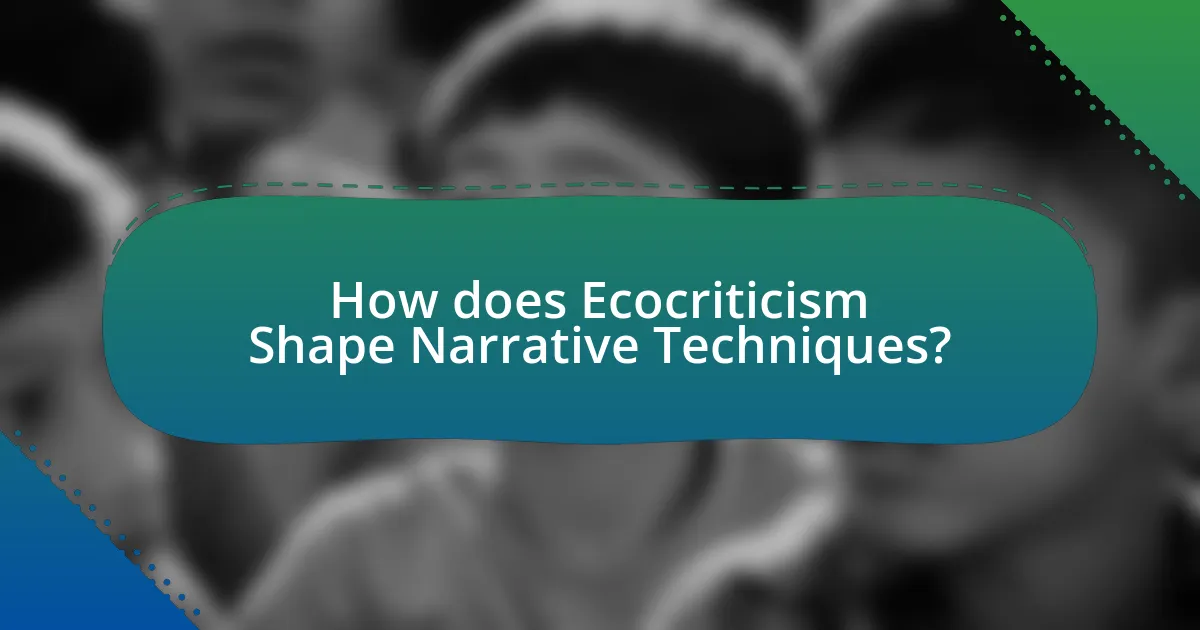
How does Ecocriticism Shape Narrative Techniques?
Ecocriticism shapes narrative techniques by emphasizing the interconnectedness of human experiences and the natural environment, leading to innovative storytelling methods. This approach often incorporates multiple perspectives, including non-human voices, to reflect ecological concerns and promote environmental awareness. For instance, narratives may utilize fragmented structures or nonlinear timelines to mirror the complexity of ecological systems, as seen in works like “The Overstory” by Richard Powers, which interweaves the lives of various characters with the life cycles of trees. Such techniques not only enhance the thematic depth of the narrative but also encourage readers to engage with environmental issues on a personal level, fostering a sense of responsibility towards nature.
What narrative forms are most impacted by ecocriticism?
Ecocriticism most significantly impacts narrative forms such as novels, poetry, and essays. These forms allow for the exploration of environmental themes, human-nature relationships, and ecological concerns. For instance, contemporary novels often incorporate ecological issues as central themes, reflecting society’s growing awareness of environmental crises. Poetry frequently employs nature imagery to evoke emotional responses and raise awareness about ecological degradation. Essays, particularly in literary criticism, analyze texts through an ecological lens, emphasizing the importance of environmental context in literature. This trend is supported by the increasing number of ecocritical studies published in literary journals, highlighting the relevance of these narrative forms in addressing ecological issues.
How do traditional narratives adapt to ecocritical themes?
Traditional narratives adapt to ecocritical themes by reinterpreting characters, settings, and plots to emphasize environmental concerns and the interconnectedness of humans and nature. This adaptation often involves portraying nature as a dynamic character that influences human actions and societal outcomes, reflecting the principles of ecocriticism which advocate for a deeper understanding of ecological relationships. For instance, classic works like “Moby-Dick” have been analyzed through an ecocritical lens, revealing themes of humanity’s impact on the environment and the moral implications of exploitation. Such reinterpretations highlight the urgency of ecological issues and encourage readers to reconsider their relationship with the natural world.
What new narrative forms have emerged from ecocritical discourse?
New narrative forms that have emerged from ecocritical discourse include ecofeminism, climate fiction (cli-fi), and nature writing that emphasizes interconnectedness. Ecofeminism combines ecological concerns with feminist perspectives, highlighting the relationship between the exploitation of nature and the oppression of women. Climate fiction addresses the impacts of climate change through speculative storytelling, often envisioning future scenarios shaped by environmental crises. Nature writing has evolved to focus on the intrinsic value of ecosystems and the human-nature relationship, promoting a deeper understanding of ecological interdependence. These forms reflect a growing awareness of environmental issues and the need for sustainable narratives in literature.
How do authors incorporate ecological themes into their storytelling?
Authors incorporate ecological themes into their storytelling by weaving environmental issues and the relationship between humans and nature into their narratives. This is often achieved through character development that reflects ecological awareness, plotlines that highlight environmental crises, and settings that emphasize the beauty or fragility of ecosystems. For instance, in works like “The Overstory” by Richard Powers, multiple characters’ lives are interconnected through their relationships with trees, illustrating the impact of deforestation and climate change. Such narratives not only raise awareness but also encourage readers to reflect on their own environmental responsibilities, demonstrating the power of storytelling in promoting ecological consciousness.
What techniques do writers use to evoke environmental awareness?
Writers evoke environmental awareness through techniques such as vivid imagery, personification of nature, and the incorporation of scientific facts. Vivid imagery allows readers to visualize environmental issues, making them more relatable and urgent. For example, descriptions of polluted landscapes or endangered species can create emotional responses that drive awareness. Personification of nature, where natural elements are given human traits, fosters a connection between readers and the environment, encouraging empathy. Additionally, integrating scientific facts and statistics about climate change or biodiversity loss provides a factual basis that underscores the urgency of environmental issues, as seen in works like Rachel Carson’s “Silent Spring,” which effectively combined narrative with scientific evidence to raise awareness about pesticide use and its ecological impact.
How does character development reflect ecocritical perspectives?
Character development reflects ecocritical perspectives by illustrating the interconnectedness between human experiences and the natural environment. In narratives that adopt ecocritical viewpoints, characters often undergo transformations that highlight their relationships with nature, emphasizing themes such as environmental stewardship, sustainability, and the consequences of ecological neglect. For instance, in literature like “The Overstory” by Richard Powers, characters evolve through their interactions with trees and ecosystems, showcasing how personal growth is tied to ecological awareness and responsibility. This alignment of character arcs with ecological themes serves to reinforce the notion that individual actions impact the environment, thereby promoting a deeper understanding of ecological issues within contemporary narratives.
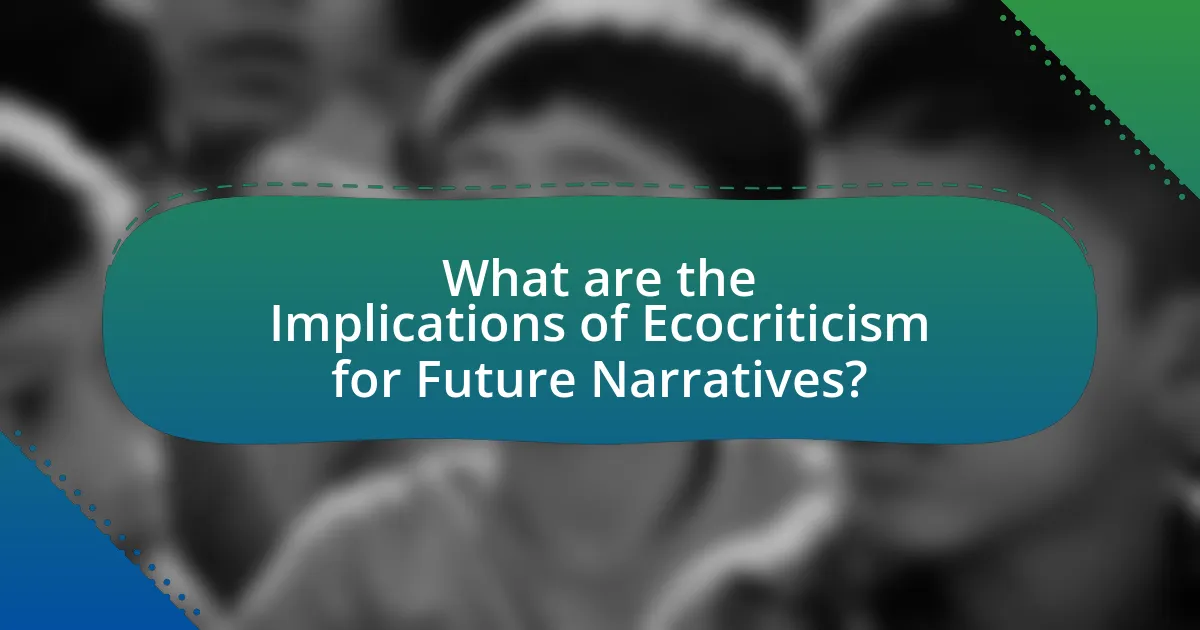
What are the Implications of Ecocriticism for Future Narratives?
Ecocriticism will significantly shape future narratives by prioritizing environmental themes and ethical considerations regarding nature. This literary approach encourages writers to explore the interconnectedness of human experiences and ecological systems, fostering a deeper awareness of environmental issues. For instance, narratives may increasingly reflect the impacts of climate change, biodiversity loss, and sustainability, as seen in works like “The Overstory” by Richard Powers, which intertwines human stories with the lives of trees. Such integration not only enhances storytelling but also promotes ecological consciousness among readers, ultimately influencing societal attitudes towards environmental stewardship.
How might ecocriticism influence future literary trends?
Ecocriticism is likely to influence future literary trends by prioritizing environmental themes and sustainability in narrative forms. As awareness of climate change and ecological issues grows, literature will increasingly reflect these concerns, leading to a rise in works that explore the relationship between humans and nature. This shift is evidenced by the increasing number of ecologically focused novels and poetry, such as those by authors like Margaret Atwood and Amitav Ghosh, who incorporate ecological themes into their storytelling. Furthermore, literary criticism is evolving to include ecocritical perspectives, encouraging writers to engage with environmental ethics and the impact of human actions on the planet. This trend suggests that future literature will not only entertain but also educate and inspire action regarding ecological issues.
What role will technology play in ecocritical narratives?
Technology will play a crucial role in ecocritical narratives by facilitating the exploration and representation of environmental issues through innovative storytelling methods. Digital platforms enable authors to integrate multimedia elements, such as interactive maps and virtual reality, which enhance the reader’s engagement with ecological themes. For instance, the use of social media can amplify the reach of ecocritical messages, allowing for real-time discussions and community building around environmental concerns. Furthermore, data visualization tools can present complex environmental data in accessible formats, making the implications of climate change more tangible for audiences. This integration of technology not only enriches the narrative experience but also fosters a deeper understanding of ecological interconnections, as evidenced by projects like “The Climate Reality Project,” which utilizes technology to raise awareness and inspire action on climate issues.
How can ecocriticism inspire new genres or styles of writing?
Ecocriticism can inspire new genres or styles of writing by emphasizing the interconnectedness of nature and culture, leading to innovative narrative forms that reflect environmental concerns. This literary approach encourages authors to explore themes such as ecological sustainability, climate change, and the human-nature relationship, often resulting in hybrid genres that blend fiction with non-fiction elements, poetry, and visual art. For instance, works like “The Overstory” by Richard Powers exemplify how narrative structures can be reimagined to incorporate multiple perspectives on ecological issues, thus fostering a deeper engagement with environmental themes. Additionally, ecocriticism has led to the emergence of speculative fiction that envisions future ecological scenarios, as seen in the works of authors like Octavia Butler and Kim Stanley Robinson, who challenge traditional storytelling by integrating scientific concepts and ethical dilemmas related to environmental crises.
What practical steps can writers take to integrate ecocriticism into their work?
Writers can integrate ecocriticism into their work by incorporating environmental themes, depicting nature authentically, and critiquing human-nature relationships. By focusing on ecological issues such as climate change, biodiversity loss, and sustainability, writers can create narratives that reflect the urgency of these topics. Additionally, portraying nature not just as a backdrop but as a character with agency enhances the ecological perspective. Research indicates that literature that emphasizes ecological awareness can influence public perception and inspire action, as seen in works like Rachel Carson’s “Silent Spring,” which raised awareness about environmental issues.
What resources are available for writers interested in ecocriticism?
Writers interested in ecocriticism can access a variety of resources, including academic journals, books, and online platforms dedicated to environmental literature. Notable academic journals such as “Environmental Humanities” and “ISLE: Interdisciplinary Studies in Literature and Environment” publish research and critical essays on ecocriticism. Key books like “The Ecocriticism Reader” edited by Cheryl Glotfelty and “Ecocriticism” by Greg Garrard provide foundational knowledge and theoretical frameworks. Additionally, websites like the Association for the Study of Literature and Environment (ASLE) offer networking opportunities, conferences, and a wealth of resources for writers. These resources collectively support the exploration and development of ecocritical perspectives in contemporary narrative forms.
How can writers effectively engage readers with ecological themes?
Writers can effectively engage readers with ecological themes by incorporating relatable characters and compelling narratives that highlight environmental issues. By creating characters who face ecological challenges, writers can evoke empathy and encourage readers to reflect on their own relationship with nature. For instance, novels like “The Overstory” by Richard Powers illustrate interconnectedness among characters and ecosystems, prompting readers to consider the impact of human actions on the environment. Additionally, using vivid imagery and descriptive language can immerse readers in the natural world, making ecological themes more tangible and urgent. Research indicates that storytelling can enhance emotional engagement, making ecological themes resonate more deeply with audiences.
